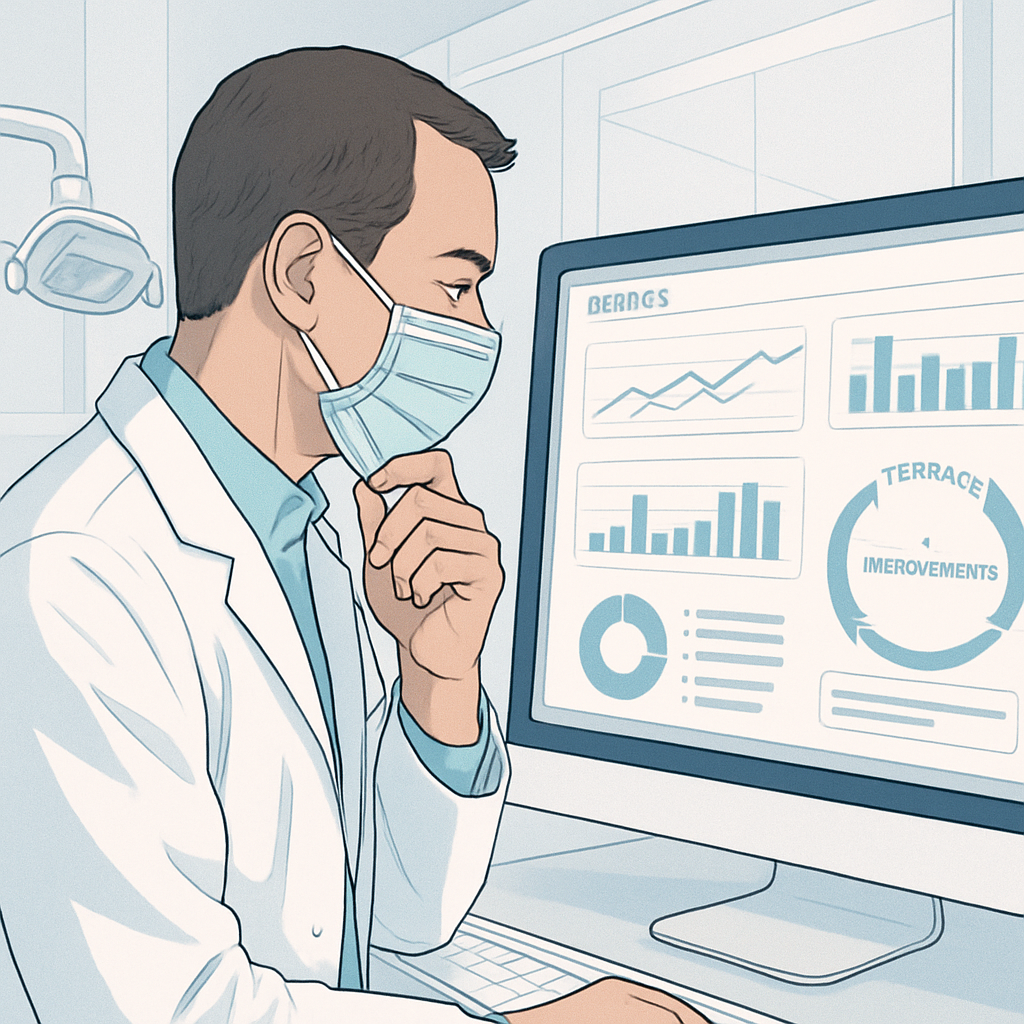November 14, 2025
7 min
Guide for multi-location dental groups to measure real ROI using defined KPIs, accurate data mapping, attribution models, cost allocation, and step-by-step methods to validate decisions.
September 2, 2025
9 minutes
Patient retention drives DSO success. Learn key metrics, strategies, and tech tools that boost loyalty, improve patient experience, and build sustainable growth.

DSOs (Dental Service Organizations) occupy an unusual place in the dental industry. They’re not dental practices themselves, but the scaffolding that allows them to thrive. What keeps them running, though—what distinguishes a thriving DSO from a forgettable one—has less to do with business wizardry than with something older: retaining patients. It’s not enough to sign new people up or spackle your name on more buildings. Sustained patient retention is the game. In this essay I’ll talk about why retention matters more than most realize in DSO land, and how to actually measure it intelligently.
When you run a single small practice, you can track your patient roster by the number of Christmas cards you receive. DSOs, by contrast, have to keep patients coming back—not just to one office, but within a network that sprawls across multiple states, each with its idiosyncrasies. Retention is the measure of whether your DSO actually delivers something people are willing to return for, and its absence shows up directly on your financial statements. But it’s not easy. If you want to keep scores of patients happy, you have to handle more than logistics. You get regulatory patchworks, cultural gulfs between offices, and the endless strain of operational friction. Let’s break down some of the core problems.
For DSOs, solving these challenges often starts with building stronger systems for centralized patient communication that streamline experiences across multiple locations.
The answer isn’t to brute-force your way through checklists. Instead, you do what startups do: experiment, adapt, and systematically watch the data. Smart DSOs use better tech, not just to automate reminders but to make the care feel personal (even if it’s not). You build feedback loops: track what patients complain about, how they respond to new touchpoints, and whether small changes in communication culture ripple into meaningful upticks in retention. Patient care isn’t just good intentions; it’s deliberate iteration from the inside out.
One effective approach is leveraging patient feedback surveys to uncover hidden issues and improve engagement across the network.

These numbers by themselves can be crude. But with the right tools—say, platforms like ThoroughCare, with dashboards that surface problems before they become fires—you can spot which locations are on track, which are lagging, and what issues consistently drive patients away. That’s how you replace vague hunches with concrete, usable feedback.
Forward-thinking DSOs are also embracing predictive analytics to forecast patient churn and intervene before loyalty slips.
The mistake most organizations make isn’t failing to buy software—it’s haphazardly piling up dashboards until no one knows where to look. Pick a handful of tools, like Weave for communication or one solid analytics suite, and relentlessly close the loop between insight and action. The root question: What does this metric tell me about how to retain the next patient who’s on the verge of drifting? For example, some DSOs rely on unified data dashboards to centralize KPIs, simplify reporting, and ensure actionable decisions get made quickly.
The DSOs that crack retention—the ones you remember—treat technology and process as ways to deliver on an honest promise of care, not just scale for its own sake. Consider Total Health Dental Care. They built a tech-enabled, multi-specialty, fee-for-service model and now run 15 offices under one recognizable brand. The result? An 87% climb in active patients: not the outcome of luck, but relentless focus on hassle-free, patient-first experience.
Total Health Dental Care escaped the constraints of insurance company gatekeeping by offering broader services under one roof, and made their workflow less about paperwork and more about actually seeing patients. This is the kind of “vertical integration” that, when executed well, feels less like a business maneuver and more like the clinic everyone wished existed in their city.
If you think brand is just a matter of signs and color schemes, you’re missing the point. For DSOs, brand is shorthand for reliability and trust. When patients talk about their experience, what they’re often describing—consciously or not—is whether they felt the clinic delivered on its implicit promises. Consistency is what makes a brand a memory, and the memory a recommendation.
Take the Women in DSO® initiative. They pushed past mere compliance and used strategic hygiene care as a concrete retention lever. By making skilled, attentive hygiene the norm, not an afterthought, they saw both loyalty and staff engagement rise, proving that operational tweaks close to the patient—like excellent cleanings—send positive shockwaves throughout the business.
The path to strong retention is the same at scale as it is in a one-room practice: the details matter, and the experience must feel personal. Here’s what forward-thinking DSOs are putting into practice.
The common thread here isn’t complexity, but deliberate focus on making the patient experience feel considered rather than accidental.
Technology, if used wisely, lets DSOs punch above their weight. AI, analytics, and digital platforms aren’t magic, but they dramatically shorten the feedback loop between patient action and DSO response. The best DSOs let their technology do the heavy lifting on logistics—which means staff can spend less time on admin and more time on real patient care. Let’s break down specifics.
AI: Multiplying Effectiveness
You see it everywhere: AI-driven tools like ConvertLens do more than churn out generic marketing. They let DSOs track and refine every leg of the patient journey, with dashboards that collapse what’s working and what isn’t into one glance. The best implementations focus less on selling features and more on illuminating the patient touchpoints where incremental improvement matters.
Uncovering Insights with Analytics
Robust analytics (again, think ThoroughCare, but any good platform suffices) spot trends even the most on-the-ball manager would miss. This is where you discover which segment is churning, when, and—crucially—why. Granular insight doesn’t just let you patch leaks; it shows where delight is possible.
Reducing Friction with Digital Tools
Automate appointment reminders, make scheduling simple, provide transparent portals—each tool is an opportunity to remove friction. The best platforms eliminate unseen administrative drag, clearing the path for higher NPS and actual satisfaction rather than imagined competence.
Simplify Your Operations
The most valuable technology doesn’t add steps; it collapses them. Automate billing, centralize communications, and let AI flag anomalies before they metastasize into complaints. When your staff isn’t drowning in process, they can actually notice patterns, follow up with care, and build lasting patient loyalty.
If you ask the top DSOs what’s coming next, their answer is inevitably a version of this: more personalization, less generic process. AI will map out ways to retain the hard-won trust of patients, not just process more claims. By 2025, patients will expect tailored interactions—from chatbots that answer real questions to individualized care plans generated by actual understanding of their history. The DSOs that adapt early will own the next decade.
AI-Led Patient Retention
AI-driven predictive analytics isn’t about replacing dentists; it’s about forecasting which patients are drifting and intervening before you lose them. Smart CRM platforms like ConvertLens don’t just categorize leads—they map which messages resonate, which interventions retain, and when to nudge or wait. This level of nuance is the new minimum.
Personalized Patient Engagement
Mass communication is dead. In 2025, the organizations that thrive will actively segment their patient population, speaking to each group’s needs, fears, and goals—not just sending out reminders. When patients see you understand their specific context, they’re far, far less likely to wander.
Seamless Patient Experience
More than ever, DSOs are investing in telehealth, on-demand scheduling, and instantaneous access to records. Convenience is king. At a certain scale, even a few new digital tools can push your retention numbers up, because patients feel—in their bones—that they’re not wading through bureaucratic molasses to get to you.
The side-benefit of all this AI and feedback collection? You get real-time, actionable data on whether your retention strategies are working—so you can keep improving, rather than settling for “good enough.”
1. What is patient retention in the context of DSO networks?
Patient retention refers to the ability of a dental service organization (DSO) to keep patients coming back for routine care and treatment. It is a critical factor in measuring the success and stability of a DSO network.
2. What metrics are commonly used to measure patient retention?
Common metrics include patient return rate, appointment completion rates, patient satisfaction scores, and reactivation rates for lapsed patients. These metrics help assess how well a DSO is retaining its patient base.
3. How can DSOs improve patient retention rates?
DSOs can improve retention by enhancing patient engagement through effective communication, providing exceptional customer service, implementing loyalty programs, and addressing patient feedback to make necessary improvements.
4. Why is it important to measure patient retention in DSO networks?
Measuring patient retention is essential for understanding the overall health of a DSO network. High retention rates indicate patient satisfaction and loyalty, which can lead to increased revenue, referrals, and a stronger reputation in the community.
Retention isn’t a back-office concern for DSOs—it’s the lifeblood. The best DSOs don’t guess; they measure, iterate, and relentlessly adjust. By caring about patient experience at every point—not just with inspections, but through real listening and smart use of tech—they build loyalty that competitors can’t buy. That’s how you win the game, quietly and over the long sweep of years.



Sign Up Now & Someone from Our Team Will Be in Touch Shortly!
Use the form below to send us a message, and we’ll get back to you as soon as we can.